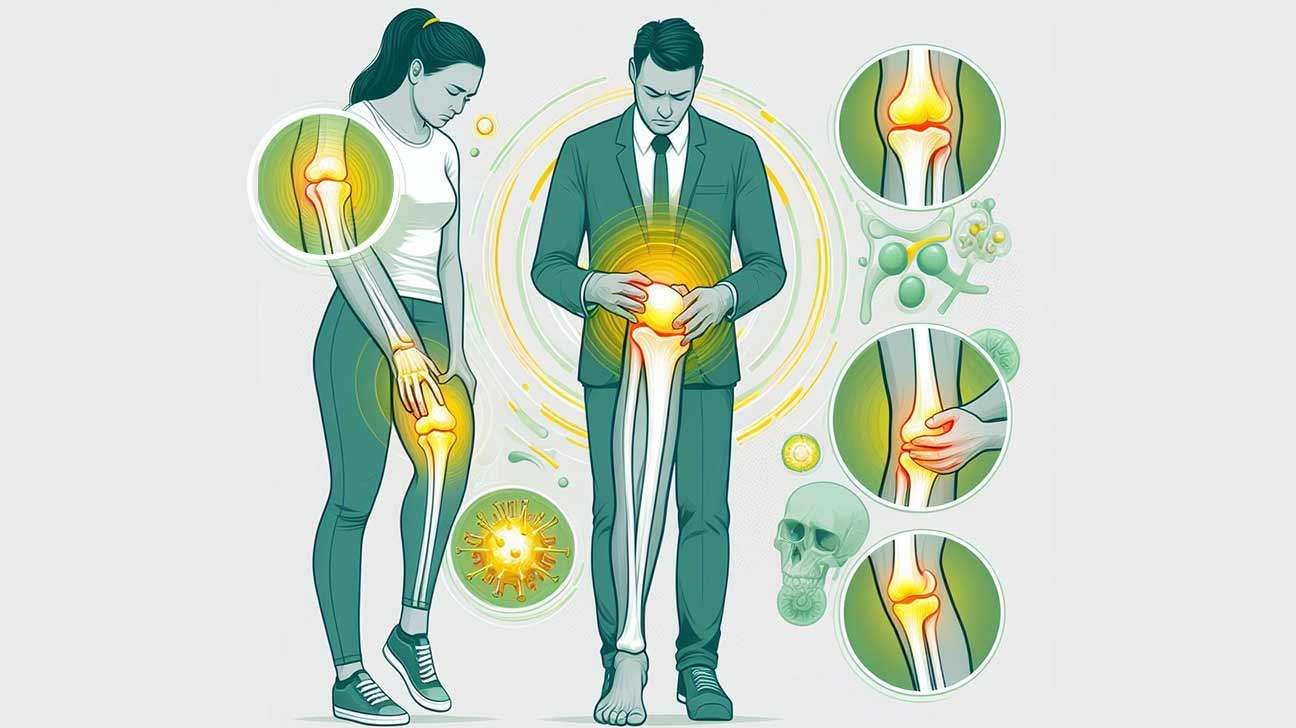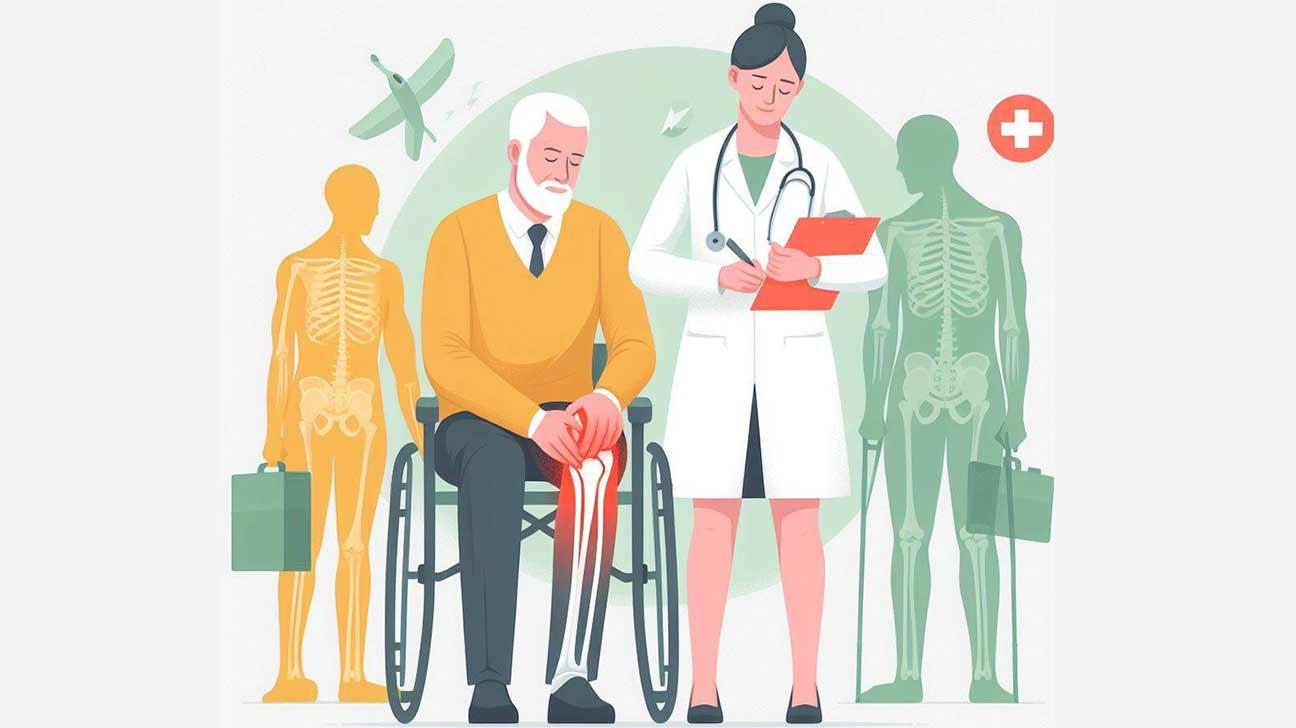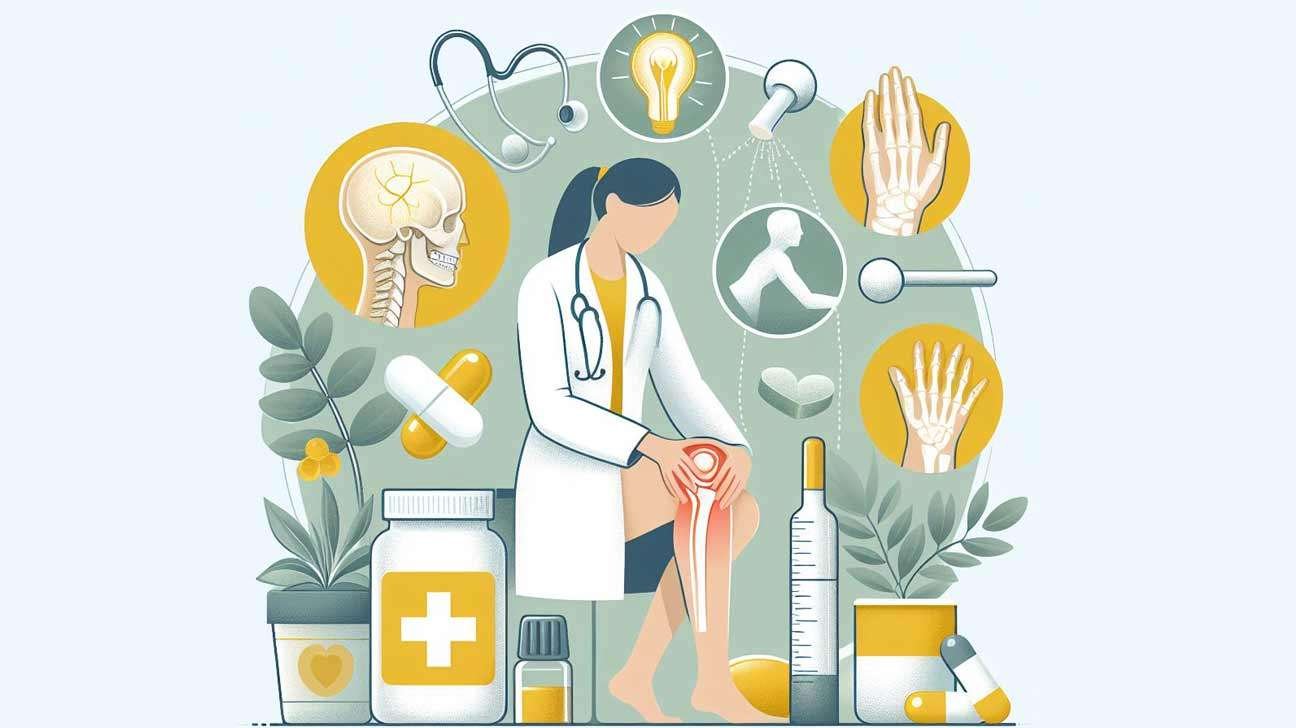Osteoarthritis (OA) is the most common form of arthritis, affecting millions of people worldwide. It occurs when the protective cartilage that cushions the ends of your bones wears down over time, leading to pain, stiffness, and decreased joint mobility. OA can affect any joint in the body, but it commonly impacts the knees, hips, hands, and spine.
Key Information About Osteoarthritis
Causes of Osteoarthritis
Osteoarthritis is primarily caused by the gradual wear and tear of joints. Several factors can contribute to the development of OA, including:
- Age: The risk of developing osteoarthritis increases with age as cartilage naturally wears down over time.
- Joint Injury: Injuries from sports, accidents, or repetitive movements can increase the likelihood of developing OA, even years after the injury.
- Obesity: Excess weight puts additional stress on weight-bearing joints like the knees and hips, accelerating cartilage breakdown.
- Genetics: A family history of osteoarthritis can increase the risk of developing the condition.
- Joint Overuse: Occupations or activities that require repetitive joint movements can lead to overuse and joint damage.
- Other Medical Conditions: Conditions such as diabetes, gout, and rheumatoid arthritis can also contribute to the development of OA.
Symptoms of Osteoarthritis
The symptoms of osteoarthritis usually develop slowly and worsen over time. Common symptoms include:
- Pain: Joint pain during or after movement.
- Stiffness: Joint stiffness, particularly after waking up or after periods of inactivity.
- Tenderness: The affected joints may feel tender when light pressure is applied.
- Loss of Flexibility: Reduced range of motion in the affected joints.
- Swelling: Swelling may occur around the joint.
- Grating Sensation: You may feel a grating or crunching sensation in the joint when moving.
Diagnosis of Osteoarthritis
To diagnose osteoarthritis, doctors may use a combination of the following:
- Medical History: Review of symptoms, family history, and risk factors.
- Physical Examination: Checking for pain, swelling, and reduced joint movement.
- Imaging Tests: X-rays or MRI scans can show the loss of cartilage, joint space narrowing, and bone changes.
- Lab Tests: Blood tests and joint fluid analysis may be done to rule out other types of arthritis.
Treatment of Osteoarthritis
While there is no cure for osteoarthritis, treatments aim to relieve symptoms and improve joint function. Treatment options include:
- Medications:
- Pain relievers: Over-the-counter options like acetaminophen and NSAIDs (e.g., ibuprofen) can help manage pain and inflammation.
- Topical treatments: Creams, gels, or patches applied to the skin over the affected joint can provide temporary pain relief.
- Corticosteroid injections: These are used to reduce inflammation in the joint.
- Physical Therapy:
- Exercises: Strengthening the muscles around the joint can improve stability and reduce pain.
- Range-of-motion exercises: These can help improve flexibility and joint movement.
- Lifestyle Modifications:
- Weight loss: Reducing weight helps decrease stress on weight-bearing joints.
- Low-impact activities: Engaging in activities like swimming or cycling can help keep joints flexible without causing further damage.
- Surgery:
- Joint replacement (arthroplasty): In severe cases, damaged joints may be replaced with artificial ones, particularly in the knees and hips.
- Joint fusion: In some cases, bones in the joint are permanently fused, stabilizing the joint and reducing pain.
- Assistive Devices:
- Devices like braces, canes, or shoe inserts can help support the joint and reduce pain during movement.
Preventing Osteoarthritis
While osteoarthritis can’t always be prevented, you can take steps to reduce the risk:
- Maintain a healthy weight: Keeping weight within a healthy range reduces stress on joints.
- Stay active: Regular exercise strengthens muscles around joints and maintains flexibility.
- Avoid joint injuries: Protect joints during physical activities and sports to prevent injuries.
- Use proper body mechanics: Whether at work or during physical activities, use proper posture and lifting techniques to reduce joint strain.
Living with Osteoarthritis
Living with osteoarthritis often involves managing pain and finding ways to stay active while protecting joints. Here are some strategies:
- Pain management: Use heat or cold therapy, take prescribed medications, and practice relaxation techniques.
- Stay mobile: Regular movement and low-impact exercises can help maintain joint flexibility and reduce stiffness.
- Join support groups: Sharing experiences with others who have OA can provide emotional support and helpful tips.
By working with healthcare providers and making lifestyle adjustments, people with osteoarthritis can manage their symptoms and maintain a high quality of life.

Information you Need To Know About Osteoarthritis
Osteoarthritis is a chronic joint condition characterized by the breakdown of cartilage. It is the most common form of arthritis, affecting millions worldwide.
Osteoarthritis (OA) leads to pain and stiffness in the joints, primarily impacting the knees, hips, hands, and spine. This degenerative disease often develops gradually over time and can significantly hinder daily activities. Age, joint injury, obesity, and genetics are key factors that increase the risk of developing OA.
Early-stage OA symptoms might be mild, but without management, they can escalate, leading to severe discomfort and reduced mobility. Treatments for osteoarthritis focus on pain relief, improving joint function, and slowing disease progression. They encompass lifestyle changes, physical therapies, medication, and in some cases, surgery. Recognizing early symptoms and seeking prompt medical advice can help manage the impact of osteoarthritis on an individual’s life.
What Is Osteoarthritis?
Osteoarthritis is a common joint condition affecting millions of people worldwide. It involves the deterioration of joint cartilage and underlying bone, which can lead to pain, stiffness, and restricted movement. This blog post delves into what osteoarthritis is, its causes, and the factors that increase the risk of developing it.
Definition
Osteoarthritis, often referred to as OA, is a degenerative joint disease. As the most prevalent form of arthritis, it mainly affects the hands, spine, hips, and knees. Cartilage, the slippery tissue that cushions the ends of bones in the joints, breaks down over time in OA patients. This breakdown leads to joint pain and restricted movement as bone begins to rub against bone.
Causes
The exact cause of osteoarthritis is not always clear, but it involves a combination of mechanical, molecular, and genetic factors. Key elements leading to OA include:
- Cartilage wear and tear: With age, the water content of the cartilage increases, and the protein makeup of cartilage degenerates.
- Repetitive use: Continuous use of specific joints over the years can damage the cartilage, leading to OA.
- Injury or overuse: Sports injuries, accidents, and overuse in certain occupations can contribute to cartilage breakdown.
Risk Factors
Certain factors may raise the likelihood of developing osteoarthritis. These include:
| Risk Factor | Description |
|---|---|
| Age | The risk of developing OA increases with age. |
| Sex | Women are more likely to develop OA, especially after menopause. |
| Genetics | A family history of OA can predispose individuals to the condition. |
| Obesity | Higher body weight adds stress to joints, especially the knees, hips, and spine. |
| Joint alignment | Poorly aligned or deformed joints might be more prone to OA. |
| Occupation | Jobs that involve heavy lifting or repetitive movements can increase OA risk. |
Symptoms Of Osteoarthritis
Osteoarthritis is a joint disease. It can make everyday tasks hard. Joints hurt and can get swollen. Here are the main signs:
Pain
Pain is a sign that often comes first. It may happen:
- During or after moving
- When you press on the area
- After not moving for a while
Stiffness
Stiffness
In osteoarthritis, stiffness may:
- Make it hard to move
- Happen when you wake up
- Last for a short time
Swelling
Swelling
Sometimes, the joint may swell. This can:
- Make the joint look bigger
- Feel soft when touched
- Cause tightness in the skin
Diagnosis Of Osteoarthritis
Osteoarthritis (OA) is a common joint disorder that requires accurate diagnosis for effective management. A healthcare provider uses several methods to diagnose OA. This can help to tailor treatment for individual needs.
Physical Examination
A physical exam helps find common signs of arthritis. The doctor will look for:
- Joint tenderness
- Swelling or redness around joints
- Limited range of motion
- Sounds during joint movement
Imaging Tests
Imaging tests provide clear pictures of bones and cartilage. This helps doctors see the extent of damage. Common imaging tests include:
- X-rays: Show bone damage and cartilage loss.
- MRI: Offers a more detailed image to detect early signs of OA.
Joint Fluid Analysis
Joint fluid analysis involves taking fluid from the joint with a needle. This fluid is then tested in a lab. The test can show:
- Inflammation levels
- Presence of crystals
- Infections
Treatment Options For Osteoarthritis
Living with Osteoarthritis can be challenging. But, don’t lose hope! Effective treatment options exist to manage pain and keep you moving. Explore these strategies to find relief and maintain your quality of life.
Medications
Several medications can ease Osteoarthritis symptoms.
- Analgesics – these provide pain relief but don’t reduce inflammation.
- NSAIDs – Nonsteroidal anti-inflammatory drugs reduce both pain and inflammation.
- Topical Creams – apply these directly to the skin over painful joints.
- Injections – Corticosteroid or hyaluronic acid shots offer temporary relief.
Physical Therapy
Physical therapy helps enhance flexibility, strength, and movement.
- Exercises – tailored exercises improve joint function.
- Manual Therapy – therapists use hands-on techniques on muscles and joints.
- Assistive Devices – tools like braces and shoe inserts can help reduce pain.
Lifestyle Changes
Making small but significant lifestyle changes is crucial.
- Weight Management – losing weight reduces joint stress.
- Exercise – low-impact activities like swimming help keep joints flexible.
- Diet – a balanced diet rich in antioxidants can help reduce inflammation.
- Rest – balance activity with periods of rest to ease symptoms.
Complementary And Alternative Therapies
Osteoarthritis can cause daily pain and stiffness. Many find relief through traditional methods. Yet, some also explore complementary and alternative therapies. These therapies offer additional forms of relief and wellness.
Acupuncture, herbal supplements, and mind-body techniques stand out. They are popular among those seeking holistic approaches. Let’s dive into each one.
Acupuncture
Acupuncture is an ancient practice. It uses tiny needles to target specific body points. This can stimulate healing and pain relief.
- May reduce joint pain
- Promotes natural healing
- Can improve function in affected joints
Herbal Supplements
Herbal supplements often come from plants. They have compounds that may help with osteoarthritis symptoms.
| Supplement | Potential Benefit |
|---|---|
| Turmeric | May lessen inflammation |
| Ginger | Could reduce pain and stiffness |
Note: Always talk with a doctor before trying supplements.
Mind-body Techniques
Mind-body techniques connect mental and physical health.
- Yoga: Boosts flexibility and joint health.
- Meditation: Aids in stress reduction.
- Tai Chi: Combines gentle movements with deep breathing.
These practices can promote pain management and improve well-being. They offer a supportive role alongside medical treatments.
Surgical Options For Osteoarthritis
Surgical options provide relief when other treatments fail. In this section, we explore effective surgeries for Osteoarthritis.
Joint Replacement
This surgery, also known as arthroplasty, removes damaged joint parts. Surgeons replace them with metal, plastic or ceramic materials. These materials mimic the shape and movement of a healthy joint. The most common replacements are knees and hips.
- Reduces pain significantly
- Improves mobility and quality of life
Joint Fusion
For smaller joints, like those in the wrist, ankle, or fingers, joint fusion helps. Surgeons remove the ends of the two bones in the joint. Then they lock those ends together until they heal into one rigid unit. This reduces pain by eliminating the joint movement that causes discomfort.
| Advantages | Considerations |
|---|---|
| Lasting pain relief | Joint motion is limited |
Cartilage Grafting
Younger individuals with small areas of cartilage damage can consider cartilage grafting. Surgeons take healthy cartilage from one part of the joint and move it to the damaged area. This can help delay joint replacement.
- Harvest healthy cartilage
- Transplant to the damaged area
- Foster new cartilage growth
Managing Osteoarthritis Pain
Osteoarthritis brings challenges that affect daily life. Pain management is essential. Strategies range from medications to natural remedies. Discover ways to cope with the discomfort and improve quality of life.
Pain Medications
Painkillers offer relief for many. Doctors may advise over-the-counter options like acetaminophen or NSAIDs. Prescription drugs are for severe pain. Use medication as directed to avoid side effects.
- Acetaminophen: Eases pain, fewer stomach issues.
- NSAIDs: Reduce inflammation, relieve pain.
- Topical creams: Apply directly to the joint.
Hot And Cold Therapy
Hot therapy relaxes muscles and increases circulation. Warm baths or heating pads are good choices. Cold therapy reduces swelling and numbs the area. Use ice packs or a bag of frozen veggies.
| Heat Therapy | Cold Therapy |
|---|---|
| Heating pads | Ice packs |
| Warm baths | Frozen vegetables |
Exercise
Regular movement strengthens muscles and maintains joint flexibility. Low-impact activities like walking, swimming, and yoga are best. Aim for a balanced routine. Consult a physical therapist for personalized exercises.
- Start with gentle stretches.
- Incorporate aerobic exercises.
- Add resistance training.
- Stay consistent for best results.
Preventing Osteoarthritis
Osteoarthritis (OA) is a common joint disorder. Preventing or delaying OA may be possible. Simple lifestyle changes help maintain joint health. This can lower the risk of developing OA. The following strategies are effective for prevention.
Maintaining A Healthy Weight
Excess weight puts more pressure on joints. The knees and hips feel it the most. Keeping a healthy weight reduces stress on joints. It can prevent joint damage. A balanced diet aids in maintaining a proper weight.
- Eat plenty of fruits and vegetables.
- Choose whole grains and lean proteins.
- Limit sugars, fats, and processed foods.
Exercising Regularly
Regular exercise strengthens muscles. It helps maintain joint flexibility. Low-impact activities such as swimming and walking are best. They put less strain on joints.
- Start with gentle stretches.
- Gradually increase activity levels.
- Include strength training and aerobics.
Protecting Joints
Proper joint care is essential. Avoid repetitive movements that strain joints. Use correct posture and ergonomics.
| Do’s | Don’ts |
|---|---|
| Use knee pads. | Avoid lifting heavy weights. |
| Take breaks often. | Sit for long stretches without moving. |
| Arrange workspaces ergonomically. | Ignore persistent joint pain. |
“` Notes to keep in mind: 1. Weight control is key in OA prevention. 2. Exercises should be low-impact to avoid joint stress. 3. Protect joints through smart work habits and tools.
Living With Osteoarthritis
Osteoarthritis is a journey. It often requires changes to daily life. Yet, with the right approach, living with its challenges is manageable. Adaptation, assistive tools, and a support network can make a big difference. Let’s explore the ways to maintain a quality life despite osteoarthritis.
Adapting Daily Activities
Adapting day-to-day tasks is key to managing osteoarthritis. It means finding simpler ways to move and work.
- Plan ahead to reduce extra trips or activities.
- Break tasks into smaller, manageable steps.
- Rest frequently to avoid overworking joints.
Assistive Devices
Assistive devices can ease the strain on your joints.
| Device | Use |
|---|---|
| Grabbers | Help pick up things without bending. |
| Canes | Provide extra support while walking. |
| Shower chairs | Allow for safer bathing. |
Support And Coping Strategies
Support groups and coping strategies can help.
- Join support groups to connect with others.
- Practice relaxation techniques to manage pain.
- Consult professionals for tailored advice.
Osteoarthritis Research And Future Directions
Osteoarthritis (OA) affects millions worldwide, leading to pain and disability. Recent research efforts aim to uncover new treatments, understand genetic influences, and develop non-invasive therapies. Innovations bring hope for improved OA management.
Emerging Treatments
New drugs and compounds are under investigation to slow OA’s progression. Researchers focus on cartilage repair and regeneration techniques.
- Stem cell therapy – Potential for cartilage healing
- Growth factor injections – Aim to restore joint function
- Bio-mechanical treatments – Offer pain relief and mobility
Genetic Studies
Genetic research could unravel OA’s complexities. Scientists study DNA to discover risk factors and tailor treatments.
| Genetic Aspect | Research Focus |
|---|---|
| Hereditary Patterns | Detecting genes linked to OA |
| Molecular Pathways | Understanding how genes affect OA development |
| Personalized Medicine | Crafting targeted treatments based on genetics |
Advancements In Non-invasive Therapies
Treatment without surgery is a key goal. High-tech options provide relief without the risks of invasive procedures.
- Bracing and orthotics – Support joints and improve alignment
- Physical therapy – Enhances strength and flexibility
- Medical devices – Use signals to promote cartilage growth
Frequently Asked Questions On Osteoarthritis
What Is The Best Thing To Do For Osteoarthritis?
The best approach for managing osteoarthritis combines regular exercise, a healthy diet, weight management, and over-the-counter pain relievers as needed. Consulting a physician for personalized treatment plans is also advisable.
What Is The Number 1 Treatment For Osteoarthritis?
The primary treatment for osteoarthritis is pain management, often involving NSAIDs or acetaminophen to reduce discomfort and maintain joint function.
What Should You Not Do With Osteoarthritis?
Avoid high-impact activities that stress your joints. Don’t ignore pain or push through it. Steer clear of a sedentary lifestyle. Limit activities causing joint swelling or strain. Refrain from smoking, as it can worsen symptoms.
How Do You Stop Osteoarthritis From Progressing?
To slow osteoarthritis progression, maintain a healthy weight, engage in low-impact exercises, eat a balanced diet, avoid joint strain, and seek medical advice for appropriate treatments. Regular checkups can monitor joint health and manage symptoms effectively.
What Causes Osteoarthritis To Develop?
Osteoarthritis is primarily caused by joint wear and tear, aging, injuries, and certain genetic factors that affect cartilage health.
Conclusion
Osteoarthritis affects millions, impacting quality of life significantly. Our understanding of it advances, offering new treatments and management strategies. Embrace an active lifestyle, informed choices, and regular consultations. Together, these steps can empower sufferers to lead more comfortable, fulfilling lives.
Take charge of your joint health today.






